Oil drilling has dropped on the Fort Berthold Indian Reservation in western North Dakota, home of the Three Affiliated Tribes. Since 2012, when the state Industrial Commission began reporting drilling data on Fort Berthold, the number of active rigs on the reservation has fallen by 20 percent (see chart).
Drilling on tribal property—land held in trust by the federal government for either the tribes or individual tribal members—has declined even more. In contrast, drilling on “fee land,” private property within the reservation boundary, has increased over the same period. Meanwhile, drilling activity in the rest of the Bakken region decreased, but by a smaller percentage than Fort Berthold, and in recent months the rig count outside the reservation has increased.
Fort Berthold has benefited from hundreds of millions of dollars in annual oil tax and lease revenue that has buoyed the tribes’ economic fortunes. A slowdown in drilling on trust land could reduce the flow of these revenues, at least in the short term.
The reasons for the drilling pullback aren’t clear, but oil industry sources cite reservation fees as a factor. In addition to state well permitting fees, oilfield operators on the reservation pay a federal drilling fee of $6,500, plus various fees charged by the tribal government, including drilling fees and licensing charges for vehicles and contractors. In 2013, the tribes collected over $20 million in fee income.
“[Drilling firms] say that it’s too costly [to operate] on the reservation because of all the additional fees,” said Steve Kelly, owner of Trustland Oil Services, an oilfield services firm in New Town, N.D. Some charges, such as federal and tribal drilling fees, apply to trust land but not to fee land.
This year, tribal officials proposed additional fees—right-of-way charges for pipeline development on the reservation and royalties on natural gas that oil companies flare at the wellhead.
Recently tightened state rules for flaring may offer another disincentive for reservation drilling. Almost half of the gas produced on the reservation is flared due to inadequate gas gathering infrastructure. The gas pipeline network is particularly thin in the western part of the reservation, which is mostly tribal land.
For much more on energy development on the reservation and its impact on the tribes, see the forthcoming October issue of the fedgazette.






